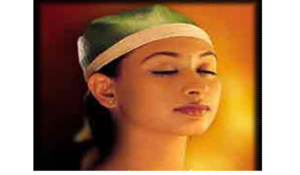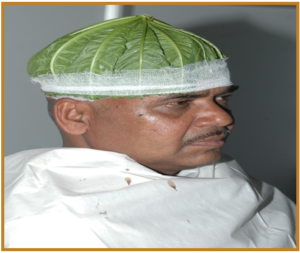It is a Bahirparimarjana langhana upakrama. It is one of the most popular therapeutic procedures in south India. It is conceptually based on lepa chikitsa and applied locally.
OBJECTIVE
To carry out Thalapodichil in the cases of Shirashula, Bhrama, Pakshaghata & Kapha Samsrusta vatavyadhi etc.
Materials Required:
- Amalaki Churna
- Raasna Churna
- Mustha
- Dhanavantaram Thaila
- Takra
- Earthen vessels
- Eranda patra
Indication:
- Hemiplegia.
- Facial Paralysis.
- Insomnia.
- Migraine.
- Scalp dermatitis.
- Eye disorders.
- Depression & Stress related conditions.
Procedure:
Step I: The scalp hairs of the patient should be removed, then he should be in a sitting posture & apply oil over the scalp with gentle massage over it.
Step II: A shirovarthi is tied around the head.
Step III: Apply Amalaki kalka over the scalp and make lepa is not less the 3 cms thickness & must be uniform all over.
Step IV: A small pit is made at the centre of the crown and Dhanvantara Taila should be poured in it.
Step V: An Eranda patra is wrapped over lepa & tied with a varthi.
Step VI: – The oil with a crown part of the lepa in square portion should be changed after the 20 min of time.
Step VII: – After the completion of 40 min. lepa should be removed & Raasnadi Churna is applied over the scalp.
Pharmacology of Lepana
- A molecules of the topical preparations can penetrate the skin by three routes through
- Intact stratum corneum.
- Sweat glands.
- Sebaceous follicles.
- The surface of the stratum corneum presents more than 99 % of the total skin surface available for percutaneous drug absorption.
- The major steps involved in percutaneous absorption include the establishment of a concentration gradient which provides the driving force for drug movement across the skin, release of drug from the vehicle and drug diffusion across the layers of the skin.
- Preferable characteristics of topical drugs include low molecular mass (600da) adequate solubility in oil & water and a high partition co-efficient.
According to the Laws of Diffusion
J = C k D/x
- J = Rate of absorption
- C = Concentration of Drug in vehicle (Amalaki churna)
- K = Partition coefficient (Takra)
- D = Duffusion coefficient (Skin)
- X = Thickness of stratum corneum
According to absorption Theory
- The hydration status of the skin is a to absorption of the external applications
- Increase in the water content of the stratum corneum increases the absorption of the topicals applied
- The mechanism of drug of action is stimulated when it enters the peripheral circulation through sub cutaneous blood vessels.
- Abhyanga over the head using Dhanavantara taila which helps in increase of cutaneous circulation and opening of sweat glands. Thus helps in Pharmacodynamics of the drug.
Amalaki indiacated in:
- Daurabalya.
- Anti atherosclerotic activitiy.
- Antioxidant.
- Phyllembblin acts as an antagonist.
Eranda patra : It is vatahara, covering of lepa with this leaf, increases the hydration of the skin and thus helps in the absorption.
Dhanvantara Taila: It is kept in the small pit at the centre of the crown maintains the body temperature and protects the marma.
Rationality
- Shiras is Uttamanga, Marmasthana, Pranayatana & Indriyasthana.
- Kapha samsrusta vata dosha, Tiryakgata raktapitta & Marmabhighata can cause various Neurovascular disorders.
- So due to Kaphahra, Rukshana, Vatanulomana & Shamana effects, Thalapodichil is effective in such various ailments.
Author:
Dr. Raghavendra Shetty
Ayurveda Doctor



